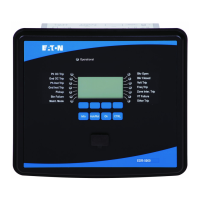EDR-5000 IM02602007E
UFLS Under Frequency Load Shedding
Available Elements:
UFLS
The number of distributed energy resources (DER) raises continuously. At the same time the controllable power
reserve through large-scale power plants decreases.
Therefore various grid codes (see also [
1
], [
2
],[
3
],[
4
],[
5
],[
6
]) requirements and regulations stipulate that mains parallel
distributed power plants, consisting of one or more power generation units feeding power into the MV grid, have to
support the grid in case of failures.
The frequency will decrease if more active power is taken out of the grid than fed into the grid.
The main task of the
Under Frequency Load Shedding
is to stabilize the grid frequency by intelligent load shedding in
order to balance produced and consumed active power.
In contrast to classical load shedding the
Under Frequency Load Shedding
will shed only those sub-grids that decrease
the frequency (because they consume active power). A shedding of sub-grids that have a positive influence on the
frequency (because they feed active power) will be blocked.
By means of adaptive parameters a non-discriminating load shedding can be established.
1 Technische Anschlussregeln für die Hochspannung (VDE-AR-N 4120)
2 Technische Richtlinie „Erzeugungsanlagen am Mittelspannungsnetz“, Richtlinie für Anschluss und Parallelbetrieb
von Erzeugungsanlagen am Mittelspannungsnetz, Ausgabe Juni 2008, BDEW Bundesverband der Energie- und
Wasserwirtschaft e.V., siehe Kap. 3.2.3.2 – Blindleistungs-Unterspannungsschutz Q->&U<
3 Entso-E Operation Handbook, Policy 5, Emergency Operations, V1, August 2010
4 Distribution Code 2007. VDN, Version 1.1, August 2007
5 FNN: Technische Anforderungen an die Frequenzentlastung, Juni 2012
6 Technische Anforderungen an die automatische Frequenzentlastung
www.eaton.com 785

